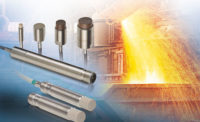Pulsed eddy currents (PEC) are a versatile nondestructive testing (NDT) technique uniquely suited to detect corrosion under insulation (CUI). PEC is an excellent screening tool because of its ability to inspect in-service components through insulation and jackets. By identifying corroded areas outside shutdown periods, PEC enables expanding the scope and frequency of inspections without affecting schedules, which allows the focused application of quantitative methods such as radiography and ultrasonic testing during shutdowns.
PEC’s working principle is this: a coil placed at some elevation (referred to as liftoff) from the surface under test (ferromagnetic and conductive) fires a magnetic pulse. First, the pulse remains active long enough for the magnetic field to penetrate the full thickness of the surface under test (referred to as the excitation phase). The pulse then abruptly stops. Eddy currents appear in the metal mass which induce a magnetic field that decays over time and can be picked up by a magnetic sensor. During the reception phase, the sensor generates a voltage signal (referred to as an A-scan) whose shape and decay rate are directly related to the thickness of the surface under test.
Controlling the length and intensity of the magnetic pulse allows inspecting carbon steel plates 3–100 mm (0.118–3.937 in) thick. The thermal insulation on the component under test is commensurate to the liftoff and can be up to 300 mm (11.8 in).
PEC can easily inspect through up to about 1 mm (0.039 in) thick aluminum or stain-less steel weather jackets over the insulation. Galvanized steel, however, impedes the de-tection and sizing performance of conventional PEC systems because of its ferromagnetic properties.
Impacts of galvanized steel weather jackets on PEC signals
Signal intensity is reduced
Galvanized steel interacts with PEC pulses in many ways. First, as the material is fer-romagnetic, it screens part of the magnetic field generated by PEC during the excitation phase. Hence, only a fraction of the magnetic field emitted by a PEC probe reaches the surface under test. The intensity of the signal from the plate detected during the reception phase is also reduced. To evaluate the importance of this effect, we calculated the magni-tude of the magnetic flux density (B) in a 12.7 mm (0.5 in) thick carbon steel plate using a yoke excitation probe configuration, 50 mm (2 in) liftoff and up to 1 mm (0.039 in) galvanized steel. The results appear in Figure 1.
With only 0.5 mm (0.02 in) of galvanized steel, the maximum magnitude of the mag-netic flux in the plate drops under 40% of the value without a jacket.
Undersizing
Another detrimental effect of galvanized steel on PEC signals is: it enlarges the mag-netic footprint of PEC probes. PEC offers the best sizing accuracy over defects larger than the probe’s footprint. Over defects smaller than the footprint, PEC signals are influ-enced by the defect and the surrounding nominal plate thickness. In this situation, the thinnest region (the defect) is averaged out by the thicker surrounding wall, leading to underestimating the defect’s wall loss. This is called defect undersizing. Galvanized steel amplifies defect undersizing by enlarging the probe’s footprint.
A-scan distortion
As galvanized steel is conductive, eddy currents in the jacket generate a magnetic field recorded by the probe’s sensor. The first few milliseconds of the received A-scan are therefore typically dominated by the galvanized steel signal. Fortunately, the decay of the galvanized steel contribution is relatively sharp compared to the signal from the much thicker surface under test. Figure 2 shows a typical A-scan from a 12.7 mm (0.5 in) thick component, 50 mm (2 in) liftoff, with and without a galvanized steel jacket. The galva-nized steel contribution may partially mask the signature of some types of defect, espe-cially defects smaller than the probe footprint.
Vibration
Finally, galvanized steel jackets vibrate during the PEC excitation and reception phas-es. Each time a PEC probe fires a pulse, the galvanized steel jacket is attracted to the probe’s magnetic field, causing a transient vibration. At a pulsation rate of 1–100 Hz, vi-brations disrupt PEC signals, as illustrated in Figure 3. Typically, the shape of vibrations and the spectral content vary according to several uncontrolled factors—the galvanized steel jacket thickness, the mechanical dampening from the insulation, the quality and tightness of jacket fixations, etc. In addition, vibrations are synchronized to PEC pulses and they cannot be eliminated by averaging over multiple pulses.
All the effects outlined above offer a sense of challenges facing PEC on components wrapped in galvanized steel, which usually result in reduced detection and sizing capabil-ities of conventional PEC systems. However, mitigation measures are possible.
Mitigating galvanized steel-related problems
There are several ways of mitigating the effects of galvanized steel on PEC inspec-tions. Vibrations can be dampened mechanically, effectively lowering the noise in A-scans. An appropriate probe design and pressing down on the probe during inspection maximizes dampening, as illustrated in Figure 4.
The important PEC signal attenuation from galvanized steel can also diminished by adjusting the probe’s design to improve the sensitivity. Depending on the type and design of magnetic sensor used, designers may have to balance sensitivity, magnetic footprint, and the dimensions and weight of the sensor.
It is possible to account for the increase in footprint caused by galvanized steel in the PEC signal analysis algorithms, effectively filtering out the effect. For example, there is a post-processing tool called the compensated wall thickness tool to do this. In essence, it estimates a defect’s wall loss by compensating undersizing.
Developing and using a PEC probe specially designed for galvanized steel is, perhaps, a more fundamental way of mitigating the adverse effects of the material on pulsed eddy currents. Permanent magnets are positioned close to the probe’s sensing coils to magneti-cally saturate the galvanized steel under the probe. The magnetic permeability of the jacket is significantly reduced, which means less of the magnetic pulse from the probe is captured by the galvanized steel. Consequently, the probe’s footprint shrinks to dimen-sions approaching the ones when there is no jacket present, which also diminishes the undersizing of small defects.
Furthermore, the distortion of A-scans from eddy currents in saturated galvanized steel is less and decays more rapidly than in unsaturated galvanized steel. Finally, the perma-nent magnets act as a sort of anchor, magnetically attracting the jacket to the probe, and effectively prevent mechanical vibrations.
In Figure 5, you can see an example of the reduced footprint (measured at the 50% contour plot of the B field) on a 0.5 mm (0.02 in) thick galvanized steel jacket compared to a conventional PEC probe.
The specialized probe’s footprint is virtually identical to the one measured without a galvanized steel jacket. The conventional probe suffers from a larger footprint because of the jacket. The smaller footprint of the specialized probe improves its detection capability and sizing accuracy. To illustrate the benefits, consider Figure 6 showing 2D sizing maps of a pipe 203.2 mm (8 in) in outer diameter, schedule 40, with 50.8 mm (2 in) thick insu-lation, a 0.7 mm (0.03 in) thick galvanized steel jacket, and a flange. Figure 6A shows a map from a conventional PEC probe—noisy from the galvanized steel vibration, making some defects hard to detect. Figure 6B shows the same map, from the galvanized steel-specialized PEC probe. You can see it is much clearer—defects are detected and sized better thanks to the smaller footprint of the probe. The probe is even able to detect a de-fect near the flange, which otherwise went undetected by a conventional probe.
Conclusion
Inspecting components wrapped in weather jackets made of ferromagnetic materials like galvanized steel is a challenge for conventional PEC systems. Their detection and sizing capabilities are impeded by the presence of galvanized steel. Precisely unwderstand-ing how galvanized steel affects PEC signals was instrumental in implementing several mitigation techniques, including the development of a novel galvanized steel-specialized probe design significantly improving the size of the footprint and signal quality on ferro-magnetic weather jackets. While accurately inspecting for CUI through galvanized steel jackets with PEC remains a challenge, it is now possible with better detection and sizing performance.









